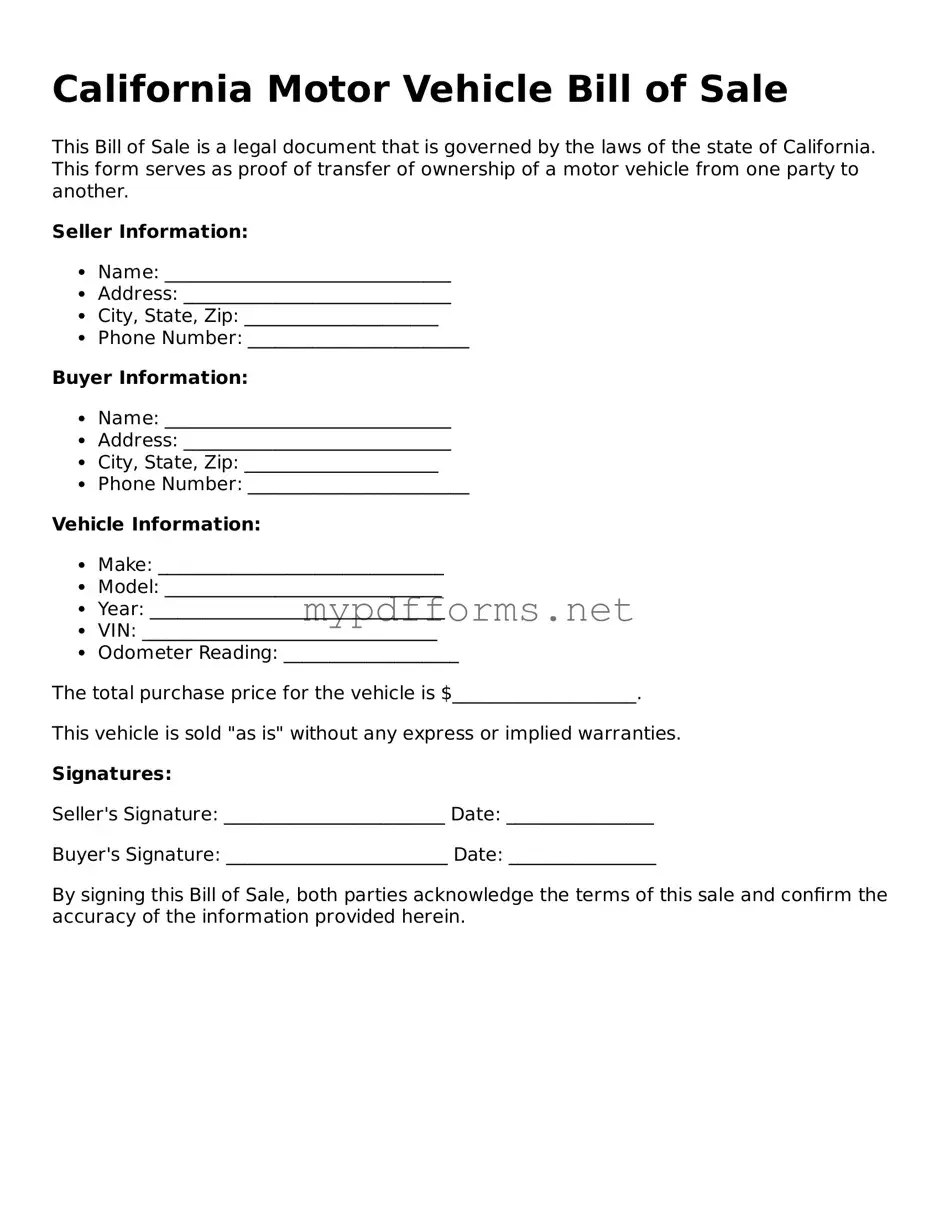The California Motor Vehicle Bill of Sale form is similar to a general Bill of Sale, which is used for various types of personal property transactions. A general Bill of Sale serves as a receipt and proof of ownership transfer between a seller and a buyer. Just like the motor vehicle version, it includes essential details such as the names of both parties, a description of the item being sold, and the purchase price. This document is crucial in establishing legal ownership and protecting both parties in the transaction.
Another document akin to the Motor Vehicle Bill of Sale is the Vehicle Title. The title serves as the official record of ownership for a vehicle. When a vehicle is sold, the seller typically signs over the title to the buyer, indicating the transfer of ownership. While the title confirms ownership, the Bill of Sale provides additional details about the transaction, such as the sale date and price, making both documents complementary in vehicle sales.
When preparing to purchase a vehicle, understanding the significance of a comprehensive Motor Vehicle Bill of Sale document can be vital. This essential form facilitates the transfer of ownership and can be accessed through detailed resources available online, such as this thorough guide on Motor Vehicle Bill of Sale processes.
The Odometer Disclosure Statement is another important document related to vehicle sales. This form is required by federal law when a vehicle is sold, and it records the vehicle's mileage at the time of sale. This protects buyers from odometer fraud. Similar to the Motor Vehicle Bill of Sale, it requires signatures from both the buyer and seller, ensuring that both parties acknowledge the vehicle's condition and mileage at the time of transfer.
A Purchase Agreement is also similar, as it outlines the terms of the sale between the buyer and seller. This document can be more detailed than a Bill of Sale, specifying payment terms, delivery conditions, and warranties. Both documents serve to formalize the agreement and protect the interests of both parties, but the Purchase Agreement often includes additional legal terms and conditions.
The Vehicle Registration application is another related document. After purchasing a vehicle, the new owner must register it with the state. The registration process typically requires the Bill of Sale as proof of ownership. While the registration confirms that a vehicle is legally recognized by the state, the Bill of Sale provides evidence of the transaction and the agreed-upon sale price.
The Certificate of Title Application is similar in that it is submitted to the Department of Motor Vehicles (DMV) when a vehicle changes ownership. This application requires information about the buyer, seller, and vehicle details. Like the Bill of Sale, it is crucial for establishing legal ownership and ensuring that the DMV has accurate records of who owns the vehicle.
A lien release document can also be considered similar, particularly when a vehicle has been financed. When the loan is paid off, the lender provides a lien release, which states that they no longer have a claim on the vehicle. This document is important for the buyer to have when transferring ownership, and it often accompanies the Bill of Sale to ensure that the title is clear of any encumbrances.
The Affidavit of Loss or Theft of Title is another document that can come into play when dealing with vehicle ownership. If a seller has lost the title to the vehicle they are selling, they may need to complete this affidavit to declare the loss formally. While it does not replace the Bill of Sale, it is essential for ensuring that the transaction can proceed legally despite the missing title.
Finally, a Warranty Deed, while typically used for real estate, shares similarities in its purpose of transferring ownership. Like a Bill of Sale, a Warranty Deed provides a written record of the transfer and can include warranties about the property’s condition. Both documents serve to protect the buyer and seller by documenting the transaction and the terms under which ownership is transferred.
